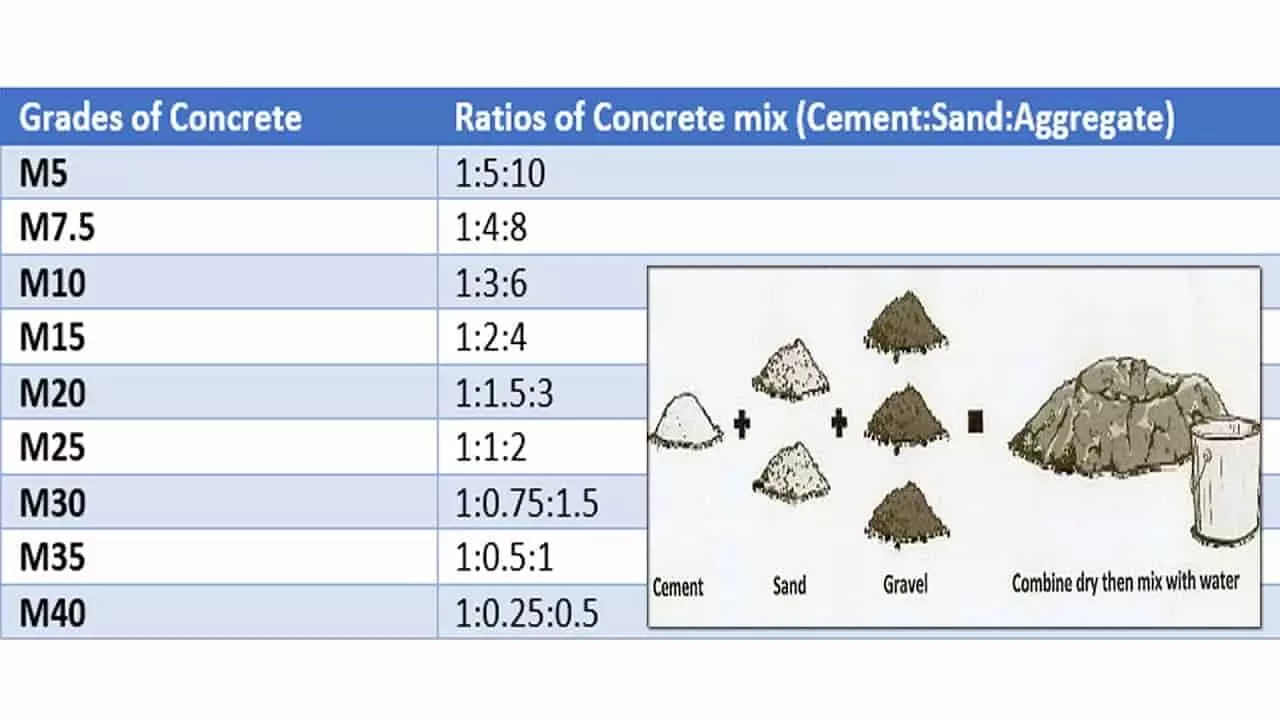Table of Contents
M25 concrete ratio is 1:1:2, which indicates the ratio of cement : sand : aggregate.
✔ It simply means that if 1 kg cement is employed for making Concrete, you should use 1 kg sand and 2 kg aggregate. ( i.e. 1 part cement: 1 part sand: 2 parts aggregate )
✔ In M25 concrete,

“M” stands for Mix ratio of cement:sand: aggregate & “25 “Stands for Compressive Strength @ 28 Days in N/mm².
✔ M25 Concrete is nominal Concrete that can be skillfully prepared using Indian Standard IS 456:2000.
✔ Normally, about 38% of water is required for the complete hydration of Concrete.
As per Indian Standard IS 456:2000, for nominal mix ( i.e. M10, M15…, M25); the w/c ratio varies from 0.4 to 0.6.
For M25 Concrete, commonly w/c ratio of 0.4 to 0.45 is used.
1. Table1: M25 Concrete Ratio – Overview
| Code | Indian Standard IS 456:2000 |
| Ratio | 1:1:2 |
| Compressive Strength | 25 MPa { Note: MPa = N/mm²} |
| Uses | Used in RCC works like; a. Used in the construction of rigid pavements with high traffic. b. Used to construct structural members like slabs, beams, columns, etc. of bridges and buildings. ( Commonly used for heavy structures or work) |
| Grade Category | Standard Grade ( Nominal Mix ) |
| Required Water Cement Ratio | a. For high-quality concrete works; 0.4 w/c ratio is specified. b. Minimum water-cement ratio: 0.40 c. Maximum water-cement ratio: 0.45 d. If plasticizers or superplasticizers are used, the w/c ratio may vary between 0.35 and 0.4. |
2. M25 Concrete Ratio Uses
This concrete grade is commonly used for medium to large-scale constructions. Some common uses of the M25 Concrete Ratio are:

✔ Used in the construction of rigid pavements with high traffic.
✔ Used to construct structural members like slabs, beams, columns, bridges, etc.
✔ Used in constructing retaining walls where heavy loads have to be retained.
3. Cement Sand Aggregate Calculation For 1 m³ M25 Concrete Ratio
Data per 1 m³
| Material | Volume Required (m3) | Bag / Farma | Materials Required in kg |
| Cement | 0.385 | 11.1 Bags | 554.4 Kg |
| Fine Aggregate | 0.385 | 11 Farma | 619.85 Kg |
| Coarse Aggregate | 0.77 | 22 Farma | 1359.82 Kg |
| Water | 0.23 | 230kg ( Average ) |
| Things To Know!! Density of Cement = 1440 kg/m3 Density of Sand = 1450-1500 Kg/m3 Density of Aggregate = 1450-1550 Kg/m3 Weight of Cement in 1 Bag = 50 Kg The volume of 1 Bag of Cement in Cubic meter = 0.03472 m3 |
Now, Taking
Grade of Concrete = M25 Concrete
Mix Ratio = 1:1:2
Total sum of ratio =1+1+2 =4
Wet volume of Concrete = 1 m3
To get dry volume, wet volume is increased by 54%
Dry volume of concrete = 1 + 0.54 = 1.54 m³
i. Cement Quantity Calculation
Quantity of cement = (Own Ratio/ Total sum of ratio) * Dry Volume
= ( 1/4 ) * 1.54
= 0.385 m³
Cement in kg = volume of cement * density of cement
= 0.385 * 1440
= 554.4 kg
ii. Sand Quantity Calculation
Quantity of sand = (Own Ratio/ Total sum of ratio) * Dry Volume
= ( 1/4 ) * 1.54
= 0.385 m³
iii. Aggregate Quantity Calculation
Quantity of aggregate = (Own Ratio/ Total sum of ratio) * Dry Volume
= ( 2/4 ) * 1.54
= 0.77 m³
iv. Water Quantity Calculation
Minimum amount of water required per m³ = 0.4*554.4 = 221.76 kg = 221.76 L
Maximum amount of water required per m³ = 0.45*554.4 = 249.48 kg = 249.48 L
4. References |
| Read Also: Grades of Concrete |
| Verified Article By Er. Madhu Krishna Poudel |

